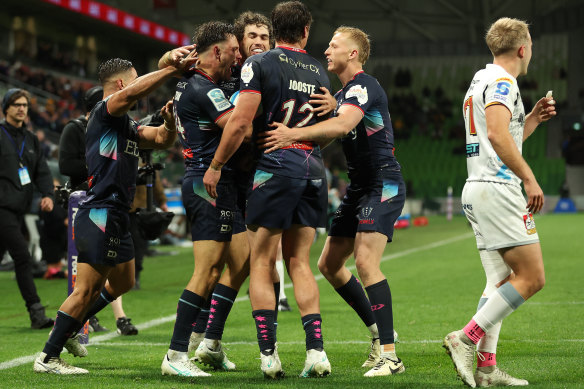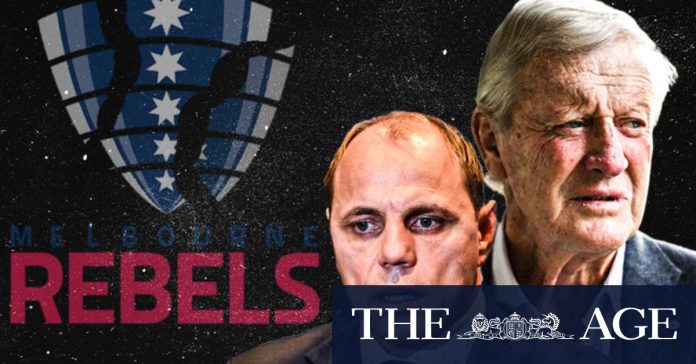[ad_1]
Rugby Australia assumed all payments for the players’ wages and funded the club for the 2024 season, and took back the club’s Super Rugby licence. It seemed then, among some rugby insiders, the peak body – itself facing financial woes – had little interest in saving the club, and would push for the Rebels to enter liquidation.
Loading
The Rebels had other plans. They developed a legal case against Rugby Australia, won a court bid to give them time to put forward a rescue deal, then convinced creditors to vote for that deal over entering liquidation.
Business magnate Leigh Clifford, was brought in to lead a private-equity consortium that promised to pump $30 million into the club and keep it surviving beyond 2025. Already the consortium was claiming to be on the way to raising that sum.
Last Wednesday, that consortium invited Rugby Australia into an online data room to view a cache of documents outlining its plan to rescue the club.
The data room included a two-phase approach to the release of information. The first phase included detailed financial modelling, plans for its high-performance participation agreement, a strategy to grow the game and the club’s commercial viability and, critically, governance and risk requests including top-line details of the consortium’s shareholders and proposed board members.
It wasn’t enough detail to quell RA’s concerns. The financial modelling also raised eyebrows at RA, with KordaMentha basing its figures – which showed revenue nearly quadrupling from $2 million to $9.8 million – on the expectation that Wyndham would soon have a greater population than Canberra.

The Melbourne Rebels will play their last game this month.Credit: Getty Images
The modelling also showed the new consortium would be a loss-making operation until 2030, when it would eke out its first profit.
Herbert was scathing of the consortium’s rescue plan on Thursday, describing it as “embryonic” and “very underdeveloped”.
“We felt that there still was a huge amount of risk, and the numbers presented in that financial modelling were very risky, and that risk … falls back to Rugby Australia if they fall short,” he said.
A senior sports administrator not involved in rugby, but speaking anonymously due to commercial sensitivities, said there were gaps in the consortium’s plan that were exacerbated by the sport’s financial position.
Rugby Australia’s key issues with the Rebels consortium rescue deal
- A reliance on extra funding from the governing body “to cover forecast operating losses” and “overly optimistic” financial projections.
- Identities of consortium members were not disclosed.
- That key advisers included at least one current or former director of the Rebels – “meaning that an individual or individuals involved were responsible for the [club] governance during the period in which the administrator considers the company may have traded while insolvent”.
- Verbal assurance but no documentation to support the claim that the consortium has committed $18 million in funding.
- No official agreement with Western Melbourne Group regarding co-location at Tarneit.
“[The Rebels have] never made money. With their proposal, it looks like they would be on the perpetual tap of Rugby Australia. There was a plan to take costs out – but not to grow fan engagements to get bums on seats, nor get significant TV audiences,” they said.
“It’s a problem of Super Rugby’s making, not just the Rebels. It’s a competition that’s lost its way very significantly.”
The administrator acknowledged the argument made by the Rebels’ side, which accused the sport of bias for taking on the NSW Waratahs’ debts in 2023: “They don’t have the money to support underfunding teams. The Waratahs are their most important market. The trouble is it has not been embraced in Melbourne.”
Loading
Despite doubts about the viability of a Melbourne team, the consortium pushed on – but the relationship between the parties was still beset with distrust.
After RA accessed the consortium data room, it appears that while one side thought it had been forthcoming, providing enough information for RA to make a decision, RA had a wildly different view.
On Monday, Rugby Australia held a regular board meeting. Several people in the Rebels camp believe it was at this meeting RA made the call to kill the club. This was flatly rejected by those in the Rugby Australia camp, who said they had been underwhelmed by the documents they’d seen, but had not made any final decision.
On Tuesday, the formidable father-daughter team of Clifford and former Rebels director and accomplished lawyer Georgia Widdup met RA to discuss phase two of the plan, which included information on identity of the consortium members, sponsors, broadcast capabilities and the Victorian government support.
It appears a key stumbling block was the request of the consortium that RA give an indication it would support the plan and sign non-disclosure agreements before learning the consortium members and other key details.
That meeting, which ran from 7pm to 9pm, became heated with both Clifford and Widdup feeling they had been rough-handled by RA representatives.
Widdup wrote to Rugby Australia chair Herbert, accusing a board director of breaching their code of conduct during a late-night meeting.
“The efforts are genuine and did not deserve to be dismissed in the manner that they were and with the contempt that was shown to all of us,” she wrote.
Herbert promptly wrote back: “From my understanding, whilst our representative may have posed some tough or uncomfortable questions, they were put in a firm but respectful way.”
He added that questions about whether Widdup, who is part of the seven directors leading legal action against RA, had a personal conflict in being involved with the rescue deal may have caused discomfort, but were important to be asked.
The animus simmering between the two parties palpable, the emergency meeting for the Rebels was called for Thursday morning.
Killed to be kind?
A close associate to the Rebels and aware of the negotiations described it as a plan of “premeditated murder” of the club.
Supporters of the Rebels point to how the sporting body choked Super Rugby clubs of funds after COVID, refusing to turn back on the funding tap after the pandemic cruelled the league’s performance.

The Melbourne Rebels at their Super Rugby launch event in 2010.Credit: Wayne Taylor
Another sign of the Rebels’ impending doom, they claim, came in July 2023 when the club’s senior officials were made aware of discussions led by Rugby Australia that a “Rebels Pasifika” team would play the British and Irish Lions in 2025, rather than a Melbourne Rebels team.
Supporters also believe that RA’s widely reported decision to centralise the ownership of the Super Rugby teams under RA’s banner in around August was another death knell for the club and by then the Rebels were dead men walking.
These claims were fervently rejected by those in the Rugby Australia camp, who said they had no interest in killing in the club, but simply were left with no other alternative. They were only made aware of the extent to the club’s losses after the tax office sent the peak body a garnishing notice at the end of December. By then, it was too late.
“It’s simply the fact that they got themselves into this position,” one senior rugby source said.
They also claim they were never made aware of the director penalty notices until it was reported by the Australian Financial Review – later confirmed in a reported filed by administrators with the corporate regulator.
Now all that is left of the club is an impending legal battle.
“Every dollar spent on lawyers is money not spent on rugby and community games and programs,” Herbert said on Thursday.
[ad_2]
Source link


